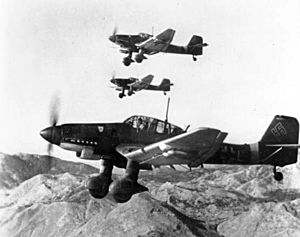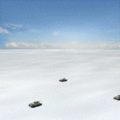Junkers Ju 87 facts for kids
Quick facts for kids Ju 87 |
|
|---|---|
 |
|
| Ju 87Ds in October 1943 | |
| Role | Dive bomber |
| Manufacturer | Junkers |
| Designer | Hermann Pohlmann |
| First flight | 17 September 1935 |
| Introduction | 1936 |
| Retired | 1945 (Luftwaffe) |
| Primary users | Luftwaffe Regia Aeronautica Royal Romanian Air Force Bulgarian Air Force |
| Number built | Estimated 6,500 |
The Junkers Ju 87, often called the Ju 87 or simply Stuka, was a famous German dive bomber aircraft. It was used during World War II. The name Stuka comes from a German word, Sturzkampfflugzeug, which means "dive bomber." This plane was known for its special design and a scary siren sound it made when diving.
The Ju 87 was designed to drop bombs very accurately. It could carry up to 500 kg of bombs. Some versions were even changed to attack tanks. About 6,500 of these planes were built in total.
The Stuka's Story
The Ju 87 was designed by Hermann Pohlmann. Its first flight was on 17 September 1935. The plane was first used in real battles in 1936. This happened during the Spanish Civil War. Stukas attacked the town of Guernica in Spain.
Stukas in World War II
When World War II began, Ju 87s were used a lot. They bombed targets in Poland, then in Belgium, the Netherlands, France, and Greece. During the Battle of Britain, Stukas attacked British ports like Dover and Folkestone. These ports were important for ships in the English Channel.
The Ju 87 was famous for its loud siren. This siren would make a terrifying whistling sound as the plane dove. This sound was meant to scare people on the ground.
Many Ju 87s were also used in the Soviet Union. They fought against Soviet troops on the Eastern Front. In the Battle of Stalingrad, Stukas bombed the city heavily.
Other Similar Aircraft
Images for kids
-
A Junkers Ju 87 B during the Battle of Stalingrad.
See also
 In Spanish: Junkers Ju 87 para niños
In Spanish: Junkers Ju 87 para niños























